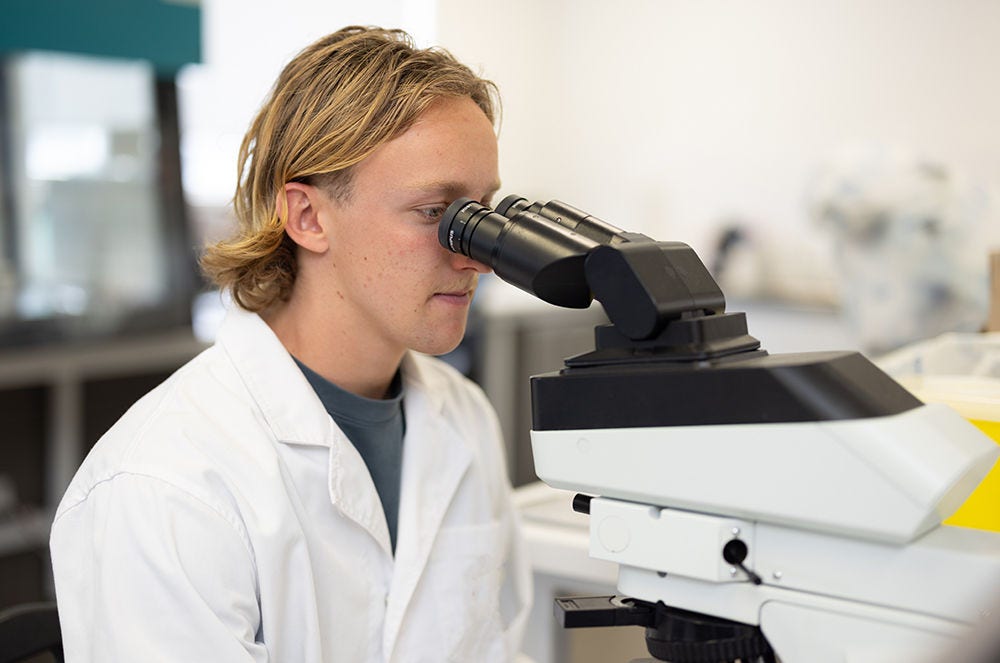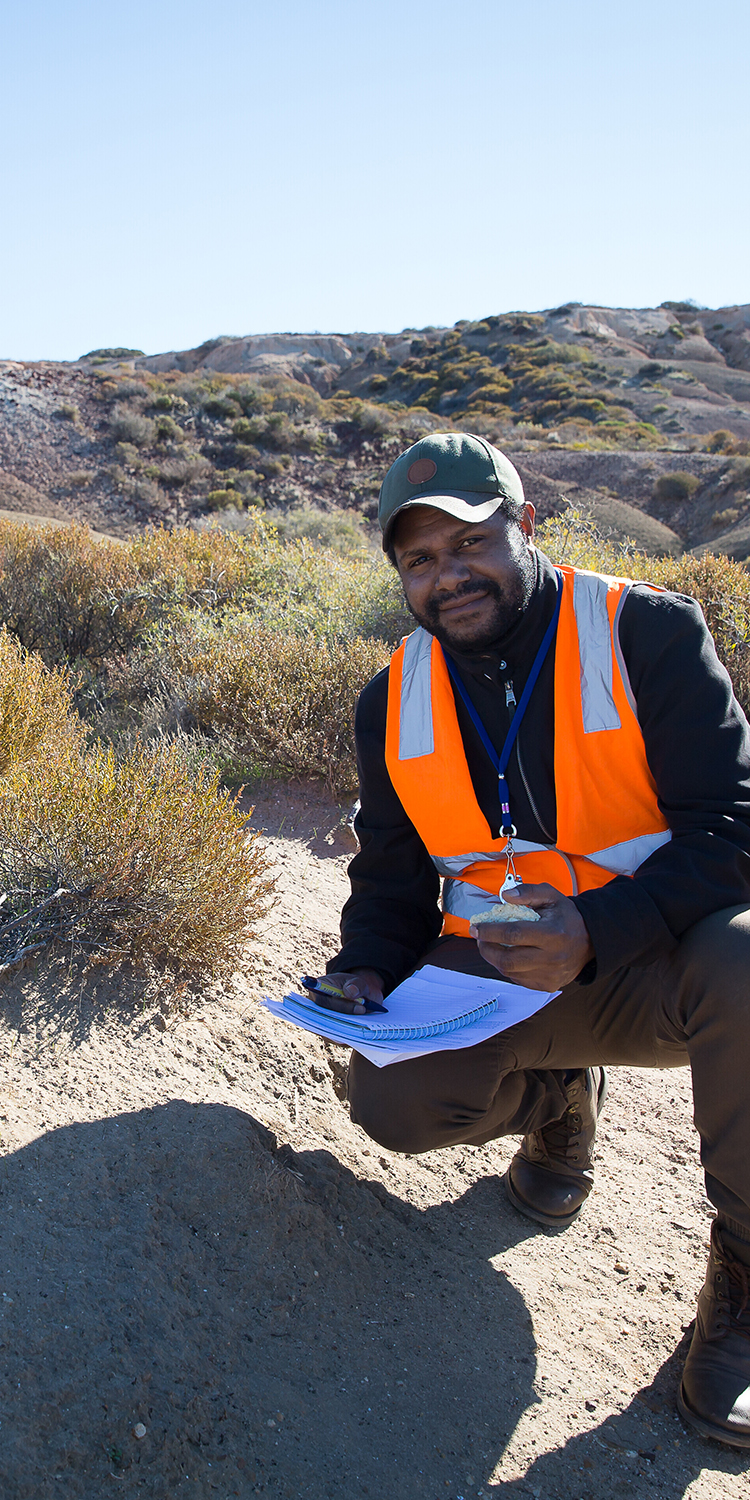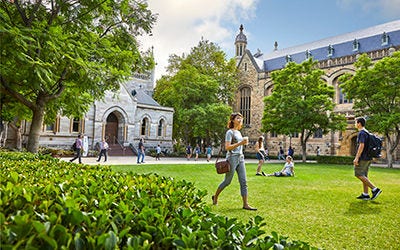Entry requirements
Admission criteria
To be eligible, an applicant must have achieved at least one of the following minimum entry requirements and demonstrate they fulfil any prerequisite and essential criteria for admission. In cases where there are more eligible applicants than available places, admission will be competitive with ranks based on the entry criteria.
Secondary education (Year 12)
- Completion of a secondary education qualification equivalent to the South Australian Certificate of Education (SACE).
Vocational Education and Training (VET)
- Completion of an award from a registered training organisation (RTO) at Certificate IV (AQF level 4) or higher.
Higher education study
- Successful completion of at least 6 months full-time study (or equivalent part-time) in a higher education award program.
English language entry requirements
In addition, international students who speak English as an additional language must have obtained one of the following standards within the last two years prior to admission. Possession of one or more of these qualifications, in addition to the academic entry requirements, does not, in itself, guarantee a place at Adelaide University. Applications are considered on an individual basis and selection is competitive. Where previous study/work experience was conducted in English, the application must be accompanied by certified documentation from the educational institution/employer certifying that the language of instruction/employment was English.
- IELTS Overall 6.5
- IELTS Reading 6
- IELTS Listening 6
- IELTS Speaking 6
- IELTS Writing 6
Please access the following link for a comprehensive list of English language tests accepted by Adelaide University and other important information in relation to meeting the University’s language requirements:
Equivalent English qualificationsInternational admissions by country
| Country | Requirement | Score |
|---|---|---|
| Australia | ATAR | 70 |
| Bangladesh | Higher Secondary Certificate (HSC) | 4.80 |
| Canada | Ontario Secondary School Diploma (OSSD) | 65% |
| China | Gaokao | 60% |
| Denmark | Studentereksamen (stx: Upper Secondary School Diploma) | 4 (Fair) |
| France | French Baccalaureate | 11.0 |
| Global | International Baccalaureate | 25 |
| Hong Kong | Diploma of Secondary Education (HKDSE) | 16 |
| India | CBSE and CISCE | 70 |
| India | State Board Examinations | 80 |
| Indonesia | SMA III | 75% |
| Kenya | Certificate of Secondary Education (KCSE) | B+ |
| Malaysia | Matrikulasi | 2.67 |
| Malaysia | Sijil Tinggi Persekolahan Malaysia (STPM) | 2.67 |
| Malaysia | United Entrance Certificate (UEC) | 23 |
| Nepal | National Examinations Board (NEB) | 2.81 |
| Norway | Upper Secondary School Certificate (Vitnemal fra den Videregaende Skole) / Vitnemal For Videregaende Opplaering | 3.2 |
| Philippines | High School Diploma (Grade 12) (Academic Track) K12 | 86% |
| Singapore | Singapore GCE Advanced Levels | 7 |
| South Korea | College Scholastic Ability Test (CSAT) | 300 |
| Sri Lanka | GCE A Levels | 8 |
| Sweden | Upper Secondary School Leaving Certificate | 13.0 |
| Taiwan | GSAT % | 60% |
| Thailand | Matayom 6 | 3.20 |
| UK / Global | GCE Advanced Levels | 7 |
| USA / Global | Advanced Placement (AP) | 7 |
| USA / Global | America College Test (ACT) | 21 |
| USA / Global | Scholastic Assessment Test (SAT) | 1100 |
| Vietnam | Bằng Tốt Nghiệp Trung Học Phổ Thông (Vietnamese Year 12) | 7.8 |
Why Bachelor of Science?
If you love technology, creative thinking and the natural world, this degree is for you. Environmental and geospatial science is about solving real-world problems, from planning better cities to protecting the environment.
It helps answer important questions. How can we rearrange cities to ease traffic and pollution? Where should we send aid after natural disasters? What’s the best location for wind and solar farms? At the heart of the field, is data.
Be at the forefront of new technologies and solutions and become an expert problem solver. Get out of the office and into nature, making a positive impact on society and the environment for future generations.
You’ll open doors to meaningful careers in fields like environmental management, urban planning and climate change analysis.

Overview
Every decision we make impacts our environment, economy and wellbeing. Our Bachelor of Science majoring in Environmental and Geospatial Science will set you up to inform major decision-making using real data. It is hands-on and tech-driven, with a strong focus on cultural awareness. You’ll learn to create interactive maps, analyse environmental data, and use geospatial technologies like drones and GPS navigators.
Classes extend beyond textbooks into real-world labs and field trips. Explore our planet’s life and weather systems. Master cartography. Participate in sustainability projects. Examine the laws shaping our future.
With skills in mapping, surveying, data analysis and conservation, you’ll be highly sought after in growing areas like agriculture, environmental consulting, urban planning and resource management.
Key features
Map, model and monitor urban and natural environments.
Use modern geospatial tech including Geographic Information Systems, web-based mapping software, and remote sensing.
Develop strategies and solutions for real environmental challenges.
Study climate resilience, renewable energy, cartography and natural hazard risks.
Get hands-on in purpose-built facilities and the living laboratories of Australia.
Learn about Aboriginal approaches to environmental management.
What you'll learn
This degree is all about how environments form and change over time. How do the living and non-living parts of our world interact? What tools and techniques help protect them? How can we chart changing landscapes?
There is so much to discover. Take foundational courses in environmental chemistry, geochemistry, biology and ecology. Develop technical skills in cartography, earth observation and Geographic Information Systems. Interpret and construct maps that are both interactive and accessible.
Hands-on experiences are central to the degree. You will:
- Collect and analyse soil, water and vegetation
- Apply marine and wildlife conservation research
- Learn the science and applications of remote sensing
- Store, manage and communicate data
- Study land management strategies including Aboriginal burning techniques
- Critically assess environmental legislation
- Unpack climate change and its socio-economic impacts.
You’ll experience a mix of online and face-to-face learning, including lectures, tutorials, workshops and practicals. You’ll get familiar with state-of-the-art geospatial tools, gather data on field trips, and network with guest experts. In your final year, you’ll undertake an 80-hour industry placement or project.
Your courses will cover:
- Earth climate and life systems
- Soils and landscapes
- Surveying and spatial sciences
- Scientific data handling and visualisation
- Environmental remote sensing
- Earth and landscape evolution
- Web cartography
- Earth Observation
- Environmental pollution and monitoring.
You can also expand your learning with electives from across Adelaide University in areas like Economics, Technology or Languages.
Majors
The Bachelor of Science is also available with majors in the following:

What courses you'll study
Complete 144 units comprising:
- 42 to 54 units for Core Courses, and
- Either:
- 30 to 90 units for one Major from Majors, or
- 48 units from Discipline courses, and
- 6 to 18 units for Work integrated learning, and
- 0 to 48 units for Electives
Complete 42 to 54 units comprising:
- 6 to 12 units for all Program Core, and
- 12 to 18 units from Common Core, and
- 6 to 30 units from Core Selective
| Course name | Course code | Units | |
|---|---|---|---|
|
Course name
Science of People, Society and the Future Planet
|
Course code
SCIE1001
|
Units
6
|
|
|
Course name
Data Skills for Scientists
|
Course code
STAT1000
|
Units
6
|
|
| Course name | Course code | Units | |
|---|---|---|---|
|
Course name
An Ethically Rich Life
|
Course code
COREX001
|
Units
6
|
|
|
Course name
Fact or Fiction: Data for Everyone
|
Course code
COREX002
|
Units
6
|
|
|
Course name
Igniting Change: Ideas to Action
|
Course code
COREX003
|
Units
6
|
|
|
Course name
Proppa Ways, Future Practice
|
Course code
COREX004
|
Units
6
|
|
|
Course name
Responsible AI: Bridging Ethics, Education and Industry
|
Course code
COREX005
|
Units
6
|
|
|
Course name
Ways of Being, Ways of Seeing
|
Course code
COREX006
|
Units
6
|
|
| Course name | Course code | Units | |
|---|---|---|---|
|
Course name
Biology 1A: Molecules, Genes and Cells
|
Course code
BIOL1003
|
Units
6
|
|
|
Course name
Biology 1B: Evolution and Diversity of Organisms
|
Course code
BIOL1004
|
Units
6
|
|
|
Course name
Foundations in Chemistry
|
Course code
CHEM1000
|
Units
6
|
|
|
Course name
Chemistry 1A
|
Course code
CHEM1002
|
Units
6
|
|
|
Course name
Chemistry 1B
|
Course code
CHEM1003
|
Units
6
|
|
|
Course name
Planet Earth
|
Course code
EART1000
|
Units
6
|
|
|
Course name
Earth, Climate and Life Systems
|
Course code
EART1012
|
Units
6
|
|
|
Course name
Foundations in Mathematics
|
Course code
MATH1000
|
Units
6
|
|
|
Course name
Calculus 1
|
Course code
MATH1004
|
Units
6
|
|
|
Course name
Calculus 2
|
Course code
MATH1005
|
Units
6
|
|
|
Course name
Foundations in Physics
|
Course code
PHYS1000
|
Units
6
|
|
|
Course name
Physics 1A
|
Course code
PHYS1001
|
Units
6
|
|
|
Course name
Physics 1B
|
Course code
PHYS1002
|
Units
6
|
|
|
Course name
Linear Algebra
|
Course code
MATHX104
|
Units
6
|
|
|
Course name
Differential Equations
|
Course code
MATHX202
|
Units
6
|
|
Notes
Program Core - Students in the following Majors will not enrol in STAT1000 Data Skills for Scientists:
Computational Physics, Experimental Physics, Nuclear and Radiation Physics, Physics and Geophysics, Space Science and Astrophysics, Theoretical Physics
Complete 90 units for ALL of the following:
| Course name | Course code | Units | |
|---|---|---|---|
|
Course name
Soils and Landscapes
|
Course code
AGRI1003
|
Units
6
|
|
|
Course name
Principles of Ecology 2
|
Course code
BIOL2051
|
Units
6
|
|
|
Course name
Introduction to Environmental Chemistry
|
Course code
CHEM1004
|
Units
6
|
|
|
Course name
Earth, Climate and Life Systems
|
Course code
EART1012
|
Units
6
|
|
|
Course name
Geochemistry 2
|
Course code
EART2011
|
Units
6
|
|
|
Course name
Landscape Evolution 3
|
Course code
EART3006
|
Units
6
|
|
|
Course name
Earth Observation for the Environmental Sciences
|
Course code
ECOL3001
|
Units
6
|
|
|
Course name
Introduction to Surveying and Spatial Sciences
|
Course code
ENGI1006
|
Units
6
|
|
|
Course name
Introduction to Remote Sensing
|
Course code
ENGI2002
|
Units
6
|
|
|
Course name
Spatial Data Acquisition and Analysis
|
Course code
ENGI2004
|
Units
6
|
|
|
Course name
Fundamentals of Climate Change
|
Course code
ENVI1001
|
Units
6
|
|
|
Course name
Microbial Ecology
|
Course code
BIOLX200
|
Units
6
|
|
|
Course name
Environmental Pollution and Monitoring
|
Course code
ENVI3010
|
Units
6
|
|
|
Course name
Fire and Culture
|
Course code
EARTX300
|
Units
6
|
|
|
Course name
Web Cartography
|
Course code
SCIE3003
|
Units
6
|
|
Complete 6 to 18 units comprising:
- One of the following:
- 12 units from Analytical Chemistry, Chemistry, Nuclear Chemistry and Pure and Applied Chemistry work integrated learning, or
- 12 units for all Animal Behaviour work integrated learning, or
- 6 units for all Animal Science work integrated learning, or
- 18 units for all Biochemistry and Biotechnology work integrated learning, or
- 6 units for all Computational Physics work integrated learning, or
- 6 units for all Ecology and Marine and Wildlife Conservation work integrated learning, or
- 12 units for all Environmental and Geospatial Science and Environmental Science work integrated learning, or
- 6 units for all Evolutionary Biology work integrated learning, or
- 12 units for all Evolutionary Biology and Palaeontology work integrated learning, or
- 6 units for all Experimental Physics work integrated learning, or
- 6 units for all Food Science and Technology work integrated learning, or
- 18 units from Genetics work integrated learning, or
- 6 units for all Geology and Geology and Earth Resources work integrated learning, or
- 6 units for all Geology and Palaeontology work integrated learning, or
- 6 units for all Geophysics work integrated learning, or
- 6 units for all Medicinal and Biological Chemistry work integrated learning, or
- 18 units for all Microbiology and Immunology work integrated learning, or
- 6 units from Nuclear and Radiation Physics and Theoretical Physics work integrated learning, or
- 12 units for all Physics and Geophysics work integrated learning, or
- 6 units for all Plant Biology work integrated learning, or
- 6 units for all Soil Science work integrated learning, or
- 6 units for all Space Science and Astrophysics work integrated learning, and
- 0 to 6 units from Additional work integrated learning - Optional
| Course name | Course code | Units | |
|---|---|---|---|
|
Course name
Organic Chemistry 3
|
Course code
CHEM3001
|
Units
6
|
|
|
Course name
Inorganic Chemistry 3
|
Course code
CHEM3002
|
Units
6
|
|
|
Course name
Physical Chemistry 3
|
Course code
CHEM3003
|
Units
6
|
|
| Course name | Course code | Units | |
|---|---|---|---|
|
Course name
Advanced Applications in Animal Behaviour
|
Course code
ANIM3900
|
Units
12
|
|
| Course name | Course code | Units | |
|---|---|---|---|
|
Course name
Professional Skills in Animal Science
|
Course code
ANIM3005
|
Units
6
|
|
| Course name | Course code | Units | |
|---|---|---|---|
|
Course name
Molecular and Biomedical Science Practical 2
|
Course code
BIOL2900
|
Units
6
|
|
|
Course name
Molecular and Biomedical Sciences Practical 3
|
Course code
BIOL3007
|
Units
6
|
|
|
Course name
Biochemistry 3: Practical
|
Course code
BIOL3011
|
Units
6
|
|
| Course name | Course code | Units | |
|---|---|---|---|
|
Course name
Computational Physics
|
Course code
PHYSX300
|
Units
6
|
|
| Course name | Course code | Units | |
|---|---|---|---|
|
Course name
Research Methods: Ecology, Marine and Wildlife 3
|
Course code
BIOL3013
|
Units
6
|
|
| Course name | Course code | Units | |
|---|---|---|---|
|
Course name
Environmental and Geospatial Field Project
|
Course code
ENVI3014
|
Units
12
|
|
| Course name | Course code | Units | |
|---|---|---|---|
|
Course name
Evolutionary Biology 3 Practical
|
Course code
BIOL3036
|
Units
6
|
|
| Course name | Course code | Units | |
|---|---|---|---|
|
Course name
Field Palaeontology 3
|
Course code
EART3002
|
Units
6
|
|
|
Course name
Evolutionary Biology 3 Practical
|
Course code
BIOL3036
|
Units
6
|
|
| Course name | Course code | Units | |
|---|---|---|---|
|
Course name
Experimental Physics
|
Course code
PHYSX301
|
Units
6
|
|
| Course name | Course code | Units | |
|---|---|---|---|
|
Course name
Science Professional Placement
|
Course code
SCIE3900
|
Units
6
|
|
| Course name | Course code | Units | |
|---|---|---|---|
|
Course name
Genetics Practical 3B
|
Course code
BIOL2016
|
Units
6
|
|
|
Course name
Molecular and Biomedical Science Practical 2
|
Course code
BIOL2900
|
Units
6
|
|
|
Course name
Molecular and Biomedical Sciences Practical 3
|
Course code
BIOL3007
|
Units
6
|
|
|
Course name
Genetics Practical 3A
|
Course code
BIOL3900
|
Units
6
|
|
| Course name | Course code | Units | |
|---|---|---|---|
|
Course name
Field Geoscience Program 3
|
Course code
EART3003
|
Units
6
|
|
| Course name | Course code | Units | |
|---|---|---|---|
|
Course name
Field Palaeontology 3
|
Course code
EART3002
|
Units
6
|
|
| Course name | Course code | Units | |
|---|---|---|---|
|
Course name
Geophysics 3C: Seismic Processing and Interpretation
|
Course code
EART3004
|
Units
6
|
|
| Course name | Course code | Units | |
|---|---|---|---|
|
Course name
Organic Chemistry 3
|
Course code
CHEM3001
|
Units
6
|
|
| Course name | Course code | Units | |
|---|---|---|---|
|
Course name
Molecular and Biomedical Science Practical 2
|
Course code
BIOL2900
|
Units
6
|
|
|
Course name
Molecular and Biomedical Sciences Practical 3
|
Course code
BIOL3007
|
Units
6
|
|
|
Course name
Microbiology and Immunology Practical 3
|
Course code
BIOL3012
|
Units
6
|
|
| Course name | Course code | Units | |
|---|---|---|---|
|
Course name
Computational Physics
|
Course code
PHYSX300
|
Units
6
|
|
|
Course name
Experimental Physics
|
Course code
PHYSX301
|
Units
6
|
|
| Course name | Course code | Units | |
|---|---|---|---|
|
Course name
Geophysics 3C: Seismic Processing and Interpretation
|
Course code
EART3004
|
Units
6
|
|
|
Course name
Experimental Physics
|
Course code
PHYSX301
|
Units
6
|
|
| Course name | Course code | Units | |
|---|---|---|---|
|
Course name
Science Professional Placement
|
Course code
SCIE3900
|
Units
6
|
|
| Course name | Course code | Units | |
|---|---|---|---|
|
Course name
Landscape Evolution 3
|
Course code
EART3006
|
Units
6
|
|
| Course name | Course code | Units | |
|---|---|---|---|
|
Course name
Experimental Physics
|
Course code
PHYSX301
|
Units
6
|
|
| Course name | Course code | Units | |
|---|---|---|---|
|
Course name
Science Professional Placement
|
Course code
SCIE3900
|
Units
6
|
|
Complete 0 to 48 units comprising:
- 0 to 48 units from Free Electives, and
- 0 to 6 units from Program electives - Animal Science major
| Course name | Course code | Units | |
|---|---|---|---|
|
Course name
Science Experience 3
|
Course code
SCIE3011
|
Units
6
|
|

Career outcomes
With environmental and geospatial skills, you’ll find career opportunities in all sorts of sectors: agriculture, transportation, energy, defence, emergency services, insurance, health – even marketing. You could map the ocean floor as a hydrographic surveyor. You might use satellite imagery and aerial photography to track habitat changes. Perhaps you’ll lead disaster responses, guiding teams to rebuild homes and businesses.
You could also become a:
- Water and land resource manager
- Urban planning officer
- Remote sensing specialist
- Business analyst
- Land surveyor
- Environmental consultant
- Geospatial analyst
- Park ranger.
Industry trends
As global environment systems change, and the pressure on natural resources grows, environmental and geospatial scientists will be asked to step up and deliver solutions. More and more, we will leverage artificial intelligence to control natural disasters and conserve ecosystems. In Australia, AI is already predicting models for bushfire management. The next generation of satellites and drones will provide even more precise data. They’ll help track future changes for mining, agricultural planning, and natural events like coral bleaching on the Great Barrier Reef.
Our Bachelor of Science majoring in Environmental and Geospatial Science will give you hands-on experience with remote sensing technology, GIS software, machine learning and data science. It integrates technical and biocultural skills, preparing you for emerging roles in the future job market.
Ready to apply?
Please note that a non-refundable application fee of AUD$150 applies for every application submitted to Adelaide University.
Your study experience and support
Adelaide University sets you up for success in your studies – and your social life. You’ll have access to work placement and internship opportunities, overseas study tours and exchanges, networking events with guest speakers and more. Our campuses are equipped with purpose-built facilities including lecture theatres, libraries, workshops, laboratories, and spaces that simulate real work environments. These are all supported by the latest technologies and a 24/7 online learning platform with personalised study information and resources.
You’ll have everything you need to live well and thrive during your studies, with health services on campus, gymnasiums, technology zones and modern student lounges. Get involved in campus sport or join our student clubs that will connect you to your passions – and the people who share them.
Adelaide also has a variety of accommodation options to suit your individual requirements and budget, with options ranging from dedicated student accommodation to private rentals. One of the world’s most liveable cities, Adelaide has lots of leafy parks, gardens and social hubs – and some of the highest living standards globally. No matter where you are in Adelaide, you’re only a short distance from beaches, vineyards, museums, art galleries, restaurants, bars and parklands. Visit the accommodation web page to find out more.
Student services
We’re here to support you on your student journey. Adelaide University offers a range of support services and facilities, including:
- Career advice and mentoring services
- Personal counselling
- LGBTQIA+ support
- Academic support
- Fees and finance help
- Security services
- Accommodation services
- Common rooms
- Prayer rooms.
You’ll also have unlimited access to our dedicated student support hub. Visit in-person or online, or contact our friendly team by phone. We can assist you with anything study-related including enrolment, identification cards, timetables, fees and more.

Your campus
You'll be studying at one of our renowned campuses, accessing cutting-edge facilities and contemporary study spaces.
Study hours
Your courses will require a combination of different learning formats, including lectures, tutorials, workshops, seminars and practicals. Aside from your classes, you’ll also need to allocate additional time for independent study. This may include assignments, readings, projects and contributing to online discussion forums. As a rough guide, full-time studies may require 12-26 hours of class time and 14-18 hours of independent study per week.
Assessment
During your studies at Adelaide University, you’ll complete a mixture of practical, professional and research-based learning. Your assessment types will vary depending on the degree you’re studying, but may include:
- Case studies
- Essays and assignments
- Examinations
- Group projects
- Internships and placements
- Practicals
- Presentations
- Reports and project documentations
- Research projects
- Workplace and classroom contributions.





